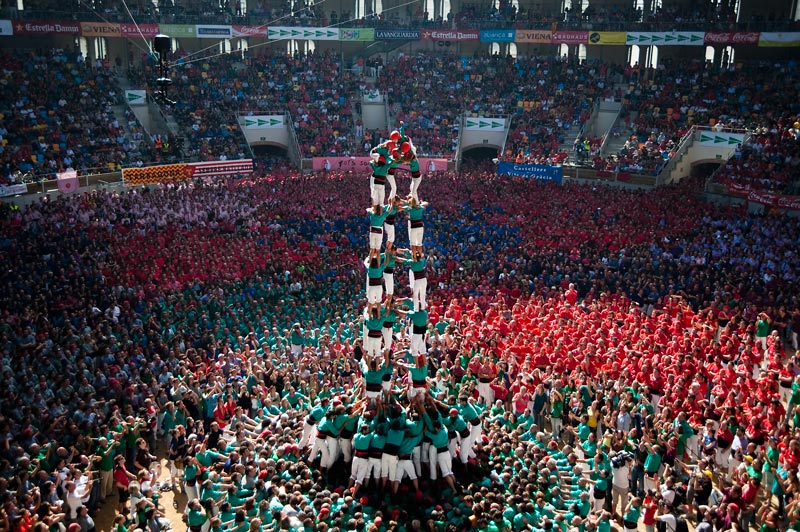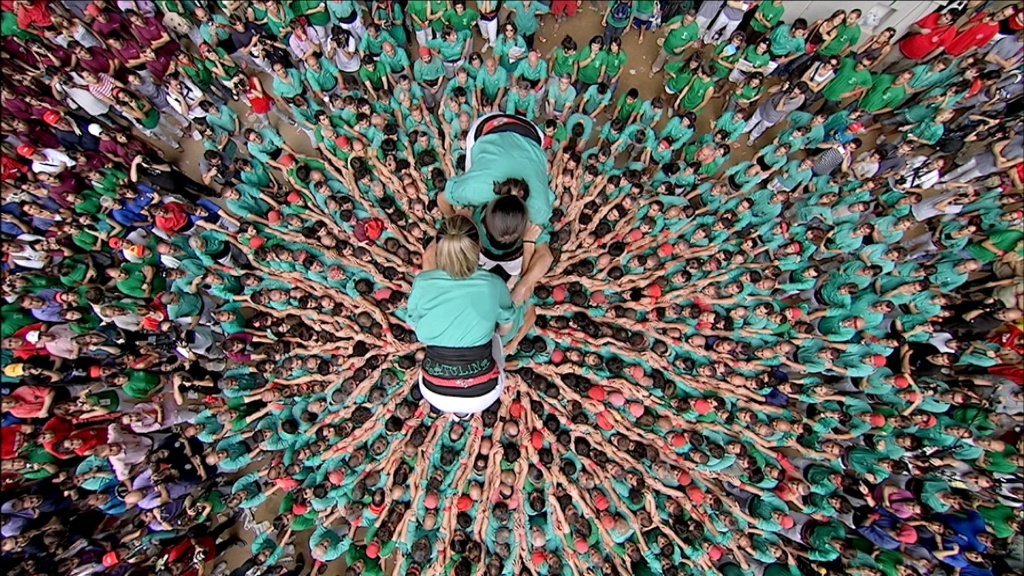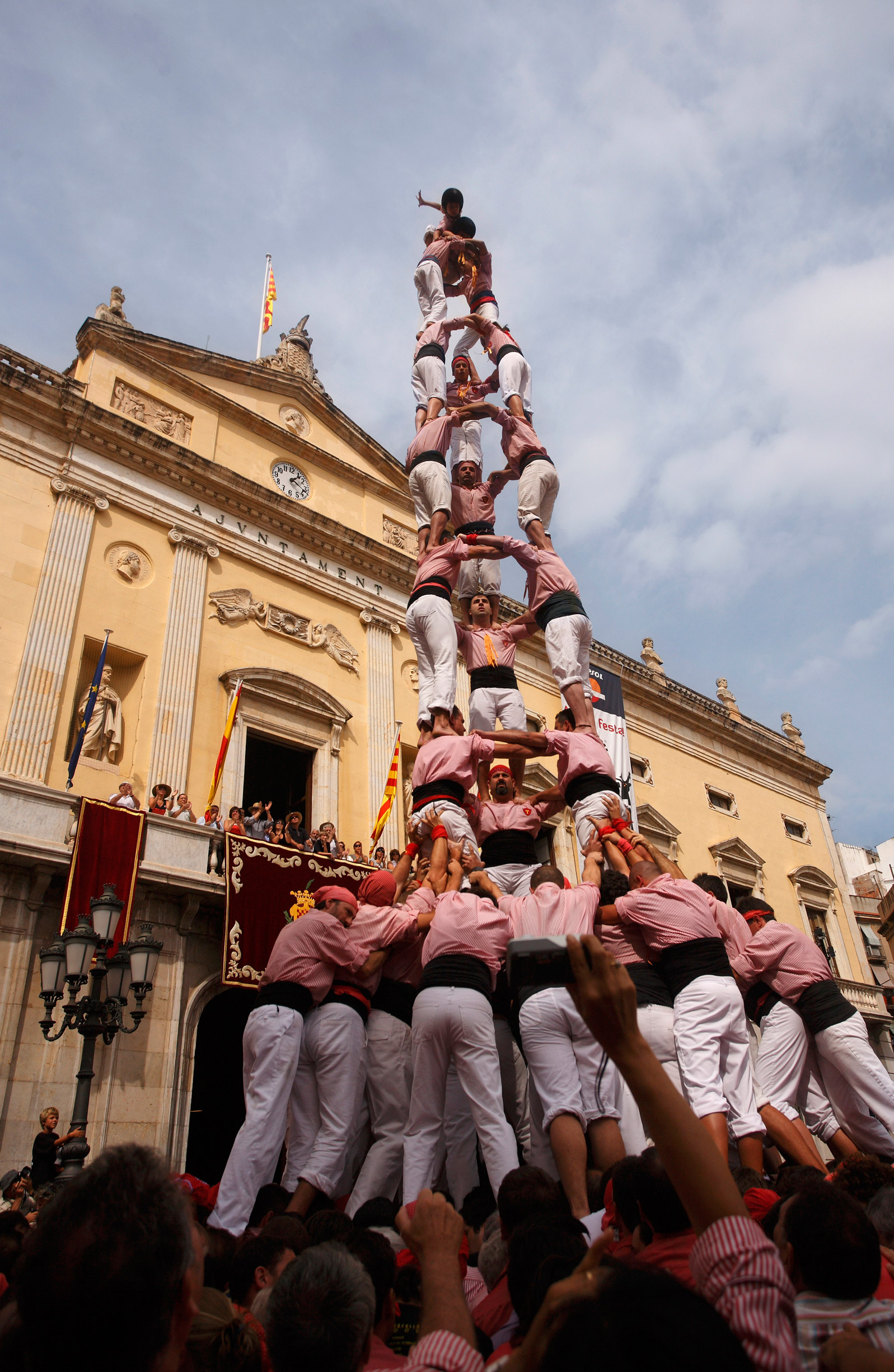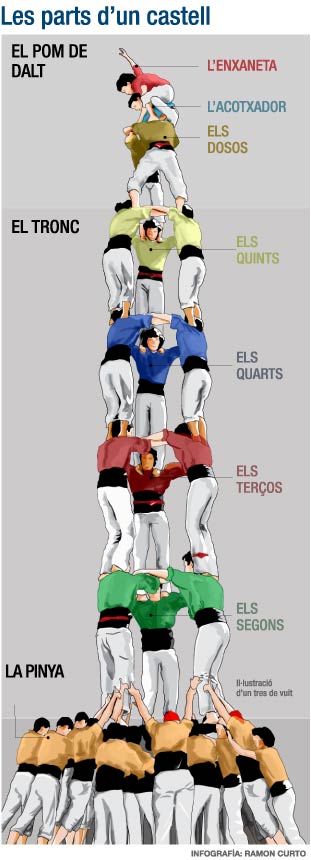
Castells, or human towers, are one of Europe's most genuine and unique cultural displays. Under the traditional motto of "strength, balance, courage and seny" (a Catalan expression encompassing virtues such as good sense and calmness), castells are an excellent way of showcasing Catalonia to the world. Watching, or even better, taking part in a castells display is a thrilling experience that really highlights under a single project the individual and collective struggle for improvement, the effort involved in achieving a goal, the solidarity and spirit of cooperation between people of all ages, conditions and abilities.
On November the 16th, in Nairobi (Kenya) Unesco aproved the inscription of human towers on the Representative List Of the Intangible Cultural Heritage of Humanity, giving then a universal recognition to this element. The Unesco statement said: "Human towers are recognized by Catalan people as an integral part of their cultural identity, transmitted from generation from generation and providing community members a sense of continuity, social cohesion and solidarity."
Making castells dates back over 200 years. Originally from the Tarragona area - specifically in Valls, the town where the idea was born - the world of castells has become increasingly popular over the last few years. A number of towns have started to adopt this festive display, spreading the practice to practically the whole of Catalonia and other Catalan-speaking areas, such as the Balearic Islands or the south of France. Over 8,000 castellers, as human tower participants are known, belonging to more than 60 colles, or registered groups, rehearse their constructions every week so they can reproduce them at the performances that normally take place at weekends. Around 8,000 castells are raised every year.

Castells were born towards the end of the XVIIIth century and the start of the XIXth in Valls, evolving from a popular dance called Ball de Valencians, that ended with the building of a human tower. During the second half of the XIXth century they lived its first Golden Age, when the first nine-floor towers were build. Still with the arrival of the XXth century castells nearly disappeared for a while (the period known as Decadence), until the creation of colles (teams) outside of Valls in 1926. The arrival of democracy and autonomous government for Catalonia at the end of the 70s strenghed human towers, and by the 90s they lived a real popularity explosion, with colles being created around the countr, the achievement of the most difficult towers and media attention.
Castells are raised in a festive atmosphere, usually as part of the annual festivals held in Catalan villages and  towns, especially in Tarragona and the Penedès region, their birthplace. The castells season starts in April and comes to an end in November, although nowadays there are a few performances during the winter months and in early spring. The groups perform, on average, about thirty times a year.
towns, especially in Tarragona and the Penedès region, their birthplace. The castells season starts in April and comes to an end in November, although nowadays there are a few performances during the winter months and in early spring. The groups perform, on average, about thirty times a year.
Performances usually take place in the town's main square, in front of the town hall, with two or three colles taking part and sorrounded by an audience that claps and cheers the performance and even actively helps the colles by melting into the pinya (the base that holds the tower).
Castells are unique in the world. Their visual impact and excitement are accompanied by great showmanship. Each castell raised to traditional music is accompanied with the uncertainty as to whether it will be completed successfully. Doubts are dispelled when it is finally raised and, once crowned by a small boy or girl, known as the enxaneta, it is dismantled stage by stage: this is known as descarregar (which literally means "to unload"). The castell is deemed only partially successful if it is crowned but falls while being dismantled.
Castells raised in a performance are rehearsed beforehand. There is little room for improvisation, as the castellers have put in hours and hours of rehearsal time to build the tower in their allotted positions.
Like any activity that arouses passion and is experienced intensely, castells also involve a certain amount of rivalry between the various groups to see who can achieve the best results. This is an incentive that spurs the groups on and motivates their efforts.
Castells are an almost completely amateur activity, as no member of a colla castellera receives any kind of payment.

Castells can be divided in three ways: by height, by the base structure (with one, two or three bases, which stand one on top of the other) and by the number of people on each stage.
Height. Castells can be 6, 7, 8, 9 or even 10 stages high. All castells have a pinya (the base that takes the weight of the tower structure - the broader the better), the tronc (the structure of castellers who climb up on top of each other and which can be from two to five stages high; it also sets the degree of difficulty of each castell) and the pom de dalt, the top three stages consisting of the dosos, the aixecador and the enxaneta, made by the youngest and smallest members of the group. Castells with 6 stages are an essential part of the repertoire, 7 stage towers are regarded as being a basic skill, while 8 stages are ranked as advanced. Castells with 9 stages (mostly with folre) are within the capabilities of very few groups. Those with 10 stages are rarely seen (having been successfully dismantled only twice in the last 200 years).
Castellers on each stage. Castells can be raised with two, three, four or five people per stage, though exceptionally there can be seven, nine or even twelve. When a tower has only one person per stage they are called pilars. The pilars are build at the beginning and at the end of a performance.
Each tower is named according to the height and the number of castellers per stage. For example, an eight stages tower with three people per stage is called tres de vuit (three by eight).
There are also special towers, because they are complex estructures (for example, castells with a pilar in the middle) or because they are build with a different tecnique (as raised from below castells).
The bases. The pinya is the base of the castell, but some larger constructions have what is known as the folre, a second smaller pinya, on top of the first. Some of the taller castells even have a third pinya, known as the manilles. The same kind of castell (for example, one of 9 stages with 4 people on each stage) can be raised with or without the folre.
Castells are an activity that, to a large extent, remains faithful to a spirit and practices dating back 200 years: being a fundamental part of the annual festival, the accompanying music, and the actual forms of the castells are just some of the elements that have been passed down from generation to generation. This link with tradition, however, does not imply that castells have not been able to change and adapt to new times. In fact, it is precisely this ability that explains their incredible longevity and the vitality they still show today.